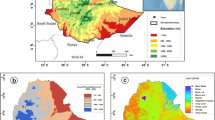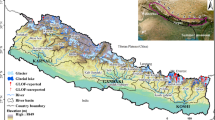Abstract
Water resources and soil erosion are the most important environmental concerns on the Chinese Loess Plateau, where soil erosion and sediment yield are closely related to rainfall erosivity. Daily rainfall data from 60 meteorological stations were used to investigate the spatiotemporal variations in annual rainfall, annual erosive rainfall and annual rainfall erosivity on the Chinese Loess Plateau during the period 1956–2008. The annual rainfall, erosive rainfall and rainfall erosivity decreased over the past five decades, as determined by the Mann–Kendall test. A comparison of the annual averaged rainfall, erosive rainfall and rainfall erosivity from 1980 to 2008 with that from 1956 to 1979 revealed a remarkable spatial difference in the rainfall trends on the Loess Plateau. Regions of the plateau with major decreases in rainfall were primarily in the Hekouzhen-Longmen section of the middle Yellow River, especially in the Wuding River basin, the Fenhe basin and the northern-central Shanxi province, where the annual rainfall and erosive rainfall decreased by more than 10% and the annual rainfall erosivity decreased by more than 15%. The rainfall erosivity also decreased more than the annual rainfall. Because the annual rainfall has decreased significantly on the Chinese Loess Plateau over the past 50 years, it is important to better understand the ecological and hydrological processes affected by this climate change.









Similar content being viewed by others
References
Angulo-Martinez M, Begueria S (2009) Estimating rainfall erosivity from daily rainfall records: a comparison among methods using data from the Ebro Basin (NE Spain). J Hydrol 379:111–121
Arnoldus HMJ (1977) Methodology used to determine the maximum potential average soil loss due to sheet and rill erosion in Marocco. Assessing soil degradation. FAO Soils Bull 34:8–9
Aronica G, Ferro V (1997) Rainfall erosivity over the Calabrian region. Hydrol Sci J 42(1):35–48
Burn DH, Cunderlik JM, Pietroniro A (2004) Hydrological trends and variability in the Laird River basin. Hydrol Sci J 49(1):53–67
Cannarozzo M, Noto LV, Viola F (2006) Spatial distribution of rainfall trends in Sicily (1921–2000). Phys Chem Earth 31:1201–1211
Chen ZH, Grasby SE (2009) Impact of decadal and century-scale oscillations on hydroclimate trend analyses. J Hydrol 365:122–133
Chen LD, Wei W, Fu BJ, Lu YH (2007) Soil and water conservation on the Loess Plateau in China: review and perspective. Prog Phys Geog 31(4):389–403
Cheng LL, Zhao WW, Zhang YH, Xu HY (2009) Effect of spatial distribution of rainfall erosivity on soil loss at catchment scale. Transactions of the CSAE 25(12):69–73 (in Chinese)
Dai SB, Yang SL, Li M (2009) The sharp decrease in suspended sediment supply from China’s rivers to the sea: anthropogenic and natural causes. Hydrol Sci J 54(1):135–146
Dixon H, Lawler DM, Shamseldin AY (2006) Streamflow trends in western Britain. Geophys Res Lett 33:L19406. doi:10.1029/2006GL027325
Domínguez-Romero L, Ayuso Muñoz JL, García Marín AP (2007) Annual distribution of rainfall erosivity in western Andalusia, southern Spain. J Soil Water Conserv 62(6):390–401
Ferro V, Porto P, Yu B (1999) A comparative study of rainfall erosivity estimation for southern Italy and southeastern Australia. Hydrol Sci J 44:3–24
Fu GB, Chen SL, Liu CM, Dawn Sheppard (2004) Hydro-climatic trends of the Yellow river basin for the last 50 years. Clim Change 65:149–178
González-Hidalgo JC, Peña-Monné JL, Luis MD (2007) A review of daily soil erosion in Western Mediterranean areas. Catena 71:193–199
Hamed KH (2009) Exact distribution of the Mann–Kendall trend test statistic for persistent data. J Hydrol 365:86–94
Hirsch RM, Slack JR, Smith RA (1982) Techniques of trend analysis for monthly water quality data. Water Resour Res 18:107–121
Huang RH, Xu YH, Zhou LT (1999) The interdecadal variation of summer rainfalls in China and the drought trend in North China. Plateau Meteorol 18(4):465–476 (in Chinese)
Kendall MG (1975) Rank correlation methods. Charles Griffin, London
Kumar S, Merwadel V, Kam J, Thurner K (2009) Streamflow trends in Indiana: effects of long term persistence, rainfall and subsurface drains. J Hydrol 374:171–183
Lin S, Wang YR (2007) Spatial-temporal evolution of rainfall in China Loess Plateau. J Desert Res 27(3):502–508 (in Chinese)
Lins HF, Slack JR (1999) Streamflow trends in the United States. Geophys Res Lett 26(2):227–230
Liu T (1985) Loess and the Environment. Science Press, Beijing, pp 62–81, 402–412 (in Chinese)
Liu Q, Yang ZF, Cui BS (2008) Spatial and temporal variability of annual rainfall during 1961–2006 in Yellow River Basin, China. J Hydrol 361:330–338
Loureiro NS, Coutinho MA (1995) Rainfall changes and rainfall erosivity increase in the Algarve (Portugal). Catena 24:55–67
Lu RY (2003) Linear relationship between the interdecadal and interannual variabilities of North China rainfall in rainy season. Chinese Sci Bull 48(10):1040–1044
Mann HB (1945) Non-parametric tests against trend. Econometrica 13:245–259
Men MX, Yu ZR, Xu H (2008) Study on the spatial pattern of rainfall erosivity based on geostatistics in Hebei Province, China. Front Agric China 2(3):281–289
Nunes JPC, Seixas J (2003) Impacts of extreme rainfall events on hydrological soil erosion patterns: application to a Mediterranean watershed. World Resour Rev 15:336–351
Oguntunde PG, Friesen J, Giesen NV, Savenije HHG (2006) Hydroclimatology of Volta River Basin in West Africa: trends and variability from 1901 to 2002. Phys Chem Earth 31:1180–1188
Renard KG, Freimund JR (1994) Using monthly rainfall data to estimate the R-factor in the revised USLE. J Hydrol 157:287–306
Renard KG, Foster GR, Weesies GA (1997) Predicting soil erosion by water: a guide to conservation planning with the revised universal soil loss equation (RUSLE). USDA Agric Handb 703:27–28
Richardson CW, Foster GR, Wright DA (1983) Estimation of erosion index from daily rainfall amount. Trans ASAE 26(1):153–156
Romero CC, Baigorria GA, Stroosnijder L (2007) Changes of erosive rainfall for El Niño and La Niña years in the northern Andean highlands of Peru. Clim Change 85:343–356
Shi H, Shao MA (2000) Soil and water loss from the Loess Plateau in China. J Arid Environ 45(1):9–20
Shi YF, Shen YP, Li DL (2003) Discussion on the present climate change from warm-dry to warm wet in northwest China. Quat Sci 23(2):152–164 (in Chinese)
State Forestry Administration (SFA) (2008) Forestry and ecological construction bulletin of China (official document)
Su RQ (1996) Rational utilization of the water resources in the Loess Plateau region. J Nat Resour 11(1):15–22 (in Chinese)
Tang KL, Chen YZ, Jing K (1991) Characteristics of soil erosion and its control on Loess Plateau. Science-Technology Press of China, Beijing (in Chinese)
Wang G, Fan Z (2002) Research on runoff and sediment change of the Yellow River, Vol. 1. Yellow River Water Conservancy Press, Zhengzhou (in Chinese)
Wang H, Yang Z, Saito Y (2007) Stepwise decreases of the Huanghe (Yellow River) sediment load (1950–2005): impacts of climate change and human activities. Global Planet Change 57:331–354
Wei J, Zhou J, Tian JL, He XB, Tang K (2006) Decoupling soil erosion and human activities on the Chinese Loess Plateau in the 20th century. Catena 68:10–15
Wischmeier WH, Smith DD (1978) Predicting rainfall erosion losses. A Guide to Conservation Planning. US Department of Agriculture, Agricultural Handbook, p 537
Xie Y, Liu BY, Zhang WB (2000) Study on standard of erosive rainfall. J Soil Water Conserv 14(4):6–11 (in Chinese)
Xin ZB, Xie ZR, Wang W (2005) Character of rainfall in Ningxia and its response to ENSO. Scientia Geographica Sinica 25(1):49–55 (in Chinese)
Xu ZX, Zhang N (2006) Long-term trend of rainfall in the Yellow River basin during the past 50 years. Geogr Res 25(1):27–34 (in Chinese)
Xu ZG, Bennett MT, Tao R, Xu JT (2004) China’s sloping land conversion program four year on: current situation and pending issues. Int Forest Rev 6:317–326
Xu JT, Yin RS, Li Z, Liu C (2006) China’s ecological rehabilitation: unprecedented efforts, dramatic impacts, and requisite policies. Ecol Econ 57:595–607
Yang T, Zhang Q, Chen YQ, Tao X, Xu CY, Chen X (2008) A spatial assessment of hydrologic alteration caused by dam construction in the middle and lower Yellow River, China. Hydrol Process 22(18):3829–3843
Yu B, Rosewell CJ (1996) An assessment of daily rainfall erosivity model for New South Wales. Aust J Soil Res 34:139–152
Yue S, Wang CY (2002) Regional streamflow trend detection with consideration of both temporal and spatial correlation. In J Climatol 22:933–946
Zhang WB (2003) Temporal and spatial distribution of rainfall erosivity in the econtone between agriculture and animal husbandry in northern China. Adv Nat Sci 13:651–654 (in Chinese)
Zhang XC, Liu WZ (2005) Simulating potential response of hydrology, soil erosion, and crop productivity to climate change in Changwu tableland region on the Loess Plateau of China. Agr Forest Meteorol 131(3–4):127–142
Zhang SR, Lu XX (2009) Hydrological responses to rainfall variation and diverse human activities in a mountainous tributary of the lower Xijiang, China. Catena 77:130–142
Zhang Y, Zhu QK (2006) Statistic analysis of erosive rainfall on the Loess Plateau. J Arid Land Resour Environ 20(6):99–103 (in Chinese)
Zhang X, Harvey KD, Hogg WD, Yuzyk TR (2001) Trends in Canadian streamflow. Water Resour Res 37:987–998
Zhang WB, Xie Y, Liu BY (2002) Rainfall erosivity estimation using daily rainfall amounts. Scientia Geographica Sinica 22:705–711 (in Chinese)
Zhang GH, Nearing MA, Liu BY (2005) Potential effects of climate change on rainfall erosivity in the Yellow River Basin of China. Trans ASAE 48(2):511–517
Zhang Q, Xu CY, Yang T (2009a) Variability of water resource in the Yellow River Basin of Past 50 Years, China. Water Resour Manag 23(6):1157–1170
Zhang Q, Xu CY, Zhang Z, Chen YD, Liu CL (2009b) Spatial and temporal variability of rainfall over China, 1951–2005. Theor Appl Climatol 95:53–68
Zhou PH, Wang ZL (1987) Soil erosion storm rainfall standard in the Loess Plateau. Bull Soil Water Conserv 7(1):38–44 (in Chinese)
Zhu YM, Lu XX, Zhou Y (2008) Sediment discharge sensitivities to climate change: an example of Longchuangjiang of the Upper Yangtze River. Global Planet Change 60(3–4):422–429
Acknowledgments
This study was financially supported by Beijing Forestry University Young scientists Fund of science and technology innovation (BLYX200926) and the National Natural Science Foundation of China (No. 40871136). The authors are grateful to Prof. Xu Jiongxin of the Institute of Geographical and Natural Resources, Chinese Academy of Sciences, and two anonymous reviewers for their useful insights and constructive comments on previous drafts.
Author information
Authors and Affiliations
Corresponding author
Rights and permissions
About this article
Cite this article
Xin, Z., Yu, X., Li, Q. et al. Spatiotemporal variation in rainfall erosivity on the Chinese Loess Plateau during the period 1956–2008. Reg Environ Change 11, 149–159 (2011). https://doi.org/10.1007/s10113-010-0127-3
Received:
Accepted:
Published:
Issue Date:
DOI: https://doi.org/10.1007/s10113-010-0127-3




